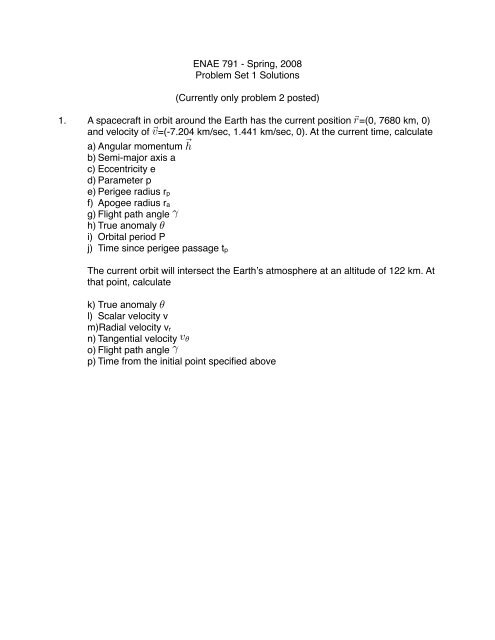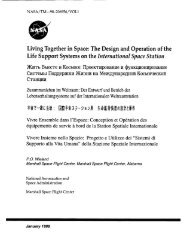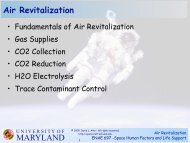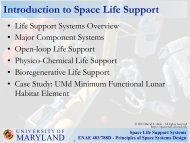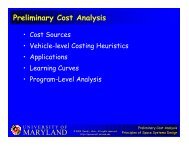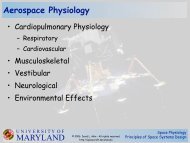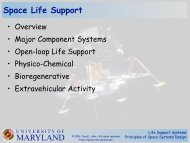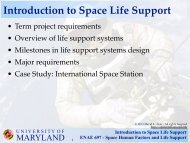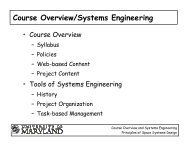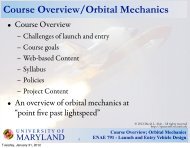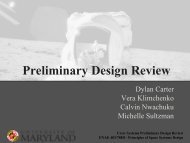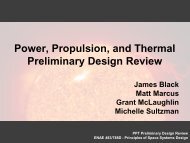ENAE 791 - Spring, 2008 Problem Set 1 Solutions (Currently only ...
ENAE 791 - Spring, 2008 Problem Set 1 Solutions (Currently only ...
ENAE 791 - Spring, 2008 Problem Set 1 Solutions (Currently only ...
You also want an ePaper? Increase the reach of your titles
YUMPU automatically turns print PDFs into web optimized ePapers that Google loves.
<strong>ENAE</strong> <strong>791</strong> - <strong>Spring</strong>, <strong>2008</strong><br />
<strong>Problem</strong> <strong>Set</strong> 1 <strong>Solutions</strong><br />
(<strong>Currently</strong> <strong>only</strong> problem 2 posted)<br />
1. A spacecraft in orbit around the Earth has the current position r=(0, 7680 km, 0)<br />
and velocity of v=(-7.204 km/sec, 1.441 km/sec, 0). At the current time, calculate<br />
a) Angular momentum h<br />
b) Semi-major axis a<br />
c) Eccentricity e<br />
d) Parameter p<br />
e) Perigee radius rp<br />
f) Apogee radius ra<br />
g) Flight path angle γ<br />
h) True anomaly θ<br />
i) Orbital period P<br />
j) Time since perigee passage tp<br />
The current orbit will intersect the Earth’s atmosphere at an altitude of 122 km. At<br />
that point, calculate<br />
k) True anomaly θ<br />
l) Scalar velocity v<br />
m)Radial velocity vr<br />
n) Tangential velocity vθ<br />
o) Flight path angle γ<br />
p) Time from the initial point specified above
2. Consider a two-stage vehicle for launching 50,000 kg of payload to Earth orbit<br />
(ΔV-9200 m/sec), and three choices for propellants in each stage: LOX/LH2,<br />
storables, and solids. Using the mean values for δ and Ve from the lecture notes,<br />
find the optimum ΔV distribution for each possible propellant combination to find<br />
the one that minimizes δ/λ. What is the gross vehicle mass and inert masses for<br />
each of the two stages for each case? (Hint: find numerical solutions, not analytic<br />
ones. Some form of mechanization (spreadsheet or Matlab) is highly<br />
recommended.)<br />
Using the parameters for Ve and δ from page 14 of the Lecture #02 notes, and choosing<br />
an arbitrary initial value for Δv2, I set up the following equations in a spreadsheet:<br />
r1 = e − ∆v1 ve r2 = e − ∆v2 ve<br />
λ1 = r1 − δ1 λ2 = r2 − δ2<br />
Mo2 = Mpl<br />
λ2<br />
Mo = Mo2<br />
λ1<br />
Min1 = δ1Mo Min2 = δ2Mo2<br />
δo = Min1 + Min2<br />
Mo<br />
λo = Mpl<br />
Mo<br />
and used Solver in Excel to find the value of Δv2 that minimizes δo/λo. By repeating<br />
this for each of the nine cases, I generated the data in the attached table. The preferred<br />
system is one where both stages are LOX/LH2, and the ΔV split is 5824/3376 m/sec.
Propellants<br />
∆v<br />
r<br />
δstage<br />
λstage<br />
Mo<br />
Minert<br />
δ0<br />
λ0<br />
δ0/λo<br />
Propellants<br />
∆v<br />
r<br />
δstage<br />
λstage<br />
Mo<br />
Minert<br />
δ0<br />
λ0<br />
δ0/λo<br />
Propellants<br />
∆v<br />
r<br />
δstage<br />
λstage<br />
Mo<br />
Minert<br />
δ0<br />
λ0<br />
δ0/λo<br />
First Stage Second First Stage Second First Stage Second<br />
Stage<br />
Stage<br />
Stage<br />
Solid Solid Solid Storables Solid Cryo<br />
4747 4453 3881 5319 2546 6654<br />
0.1805 0.2007 0.2467 0.1756 0.3992 0.2107<br />
0.087 0.087 0.087 0.061 0.087 0.075<br />
0.0935 0.1137 0.1597 0.1146 0.3122 0.1357<br />
4,700,932 439,692 2,731,243 436,129 1,179,842 368,341<br />
408,981 38,253 237,618 26,604 102,646 27,626<br />
0.0951 0.0967 0.1104<br />
0.0106 0.0183 0.0424<br />
8.945 5.284 2.605<br />
Storables Solids Storables Storables Storables Cryo<br />
5908 3292 5084 4116 3736 5464<br />
0.1449 0.3051 0.1897 0.2603 0.2947 0.2784<br />
0.061 0.087 0.061 0.061 0.061 0.075<br />
0.0839 0.2181 0.1287 0.1993 0.2337 0.2034<br />
2,733,865 229,294 1,950,087 250,893 1,051,814 245,819<br />
166,766 19,949 118,955 15,304 64,161 18,436<br />
0.0683 0.0688 0.0785<br />
0.0183 0.0256 0.0475<br />
3.734 2.685 1.652<br />
Cryo Solids Cryo Storables Cryo Cryo<br />
7984 1216 7314 1886 5824 3376<br />
0.1544 0.645 0.1805 0.5398 0.2559 0.4538<br />
0.075 0.087 0.075 0.061 0.075 0.075<br />
0.0794 0.558 0.1055 0.4788 0.1809 0.3788<br />
1,129,141 89,602 989,470 104,435 729,665 131,978<br />
84,686 7,795 74,210 6,371 54,725 9,898<br />
0.0819 0.0814 0.0886<br />
0.0443 0.0505 0.0685<br />
1.85 1.612 1.292
3. The Falcon 1e launch vehicle by SpaceX has the following properties:<br />
1 st stage empty mass - 4000 lb<br />
1 st stage propellant mass - 69,000 lb<br />
1 st stage exhaust velocity - 2979 m/sec<br />
1 st stage nominal burn time - 169 sec<br />
2 nd stage empty mass - 1125 lb<br />
2 nd stage propellant mass - 8881 lb<br />
2 nd stage exhaust velocity - 3205 m/sec<br />
Payload mass - 1529 lb<br />
Payload fairing mass - 300 lb<br />
a) Calculate the ΔV contributions of each of the stages. Assume the payload<br />
fairing is jettisoned at the same time as the first stage<br />
b) Calculate the change in total ΔV if the payload fairing is not jettisoned, but<br />
stays with the payload all the way to orbit<br />
c) How much payload would you have to give up to achieve the same total ΔV as<br />
in (a) with the payload fairing retained throughout the flight?<br />
d) Find the three trade-off ratios for both the first and second stage, assuming the<br />
fairing is jettisoned with the first stage.<br />
e) You wish to augment the payload by adding strap-on solid rocket motors to the<br />
first stage. You choose the Castor IV-A solid rocket motor, which has a total<br />
mass of 25,800 lb, a propellant mass of 22,300 lbs, an exhaust velocity of 2325<br />
m/sec, and a burning time of 56.2 seconds. Two of these motors will be added<br />
to the first stage and ignited at lift-off in parallel with the Falcon 1e first stage<br />
engine. Find the payload capacity of this system in order to reach the same ΔV<br />
as in (a).<br />
f) You need to put 5800 kg of payload into orbit [same ΔV as (a)]. You plan to<br />
mass-produce Falcon 1e first stages to build a modular launch vehicle to carry<br />
at least this much payload into orbit. Find the configuration (modules/stage and<br />
number of stages) which will accomplish this with the minimum total number of<br />
modules. You may use up to four stages. (To simplify this calculation, assume<br />
the payload fairing is carried all the way to orbit.)


